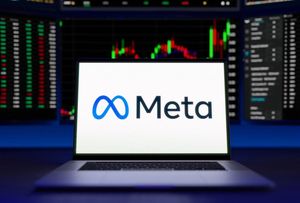
The global semiconductor industry is experiencing an unprecedented surge, largely propelled by the insatiable demand for Artificial Intelligence (AI) and high-performance computing (HPC) technologies. As of October 2025, major players in the sector have released their third-quarter earnings reports, painting a picture of exceptional financial health and an overwhelmingly bullish market outlook. These reports highlight not just a recovery, but a significant acceleration in growth, with companies consistently exceeding revenue expectations and forecasting continued expansion well into the next year.
This period marks a pivotal moment for the semiconductor ecosystem, as AI's transformative power translates directly into tangible financial gains for the companies manufacturing its foundational hardware. From leading-edge foundries to memory producers and specialized AI chip developers, the industry's financial performance is now inextricably linked to the advancements and deployment of AI, setting new benchmarks for revenue, profitability, and strategic investment in future technologies.
Robust Financial Health and Unprecedented Demand for AI Hardware
The third quarter of 2025 has been a period of remarkable financial performance for key semiconductor companies, driven by a relentless demand for advanced process technologies and specialized AI components. The figures reveal not only substantial year-over-year growth but also a clear shift in revenue drivers compared to previous cycles.
Taiwan Semiconductor Manufacturing Company (NYSE: TSM), the world's largest contract chipmaker, reported stellar Q3 2025 revenues of NT$989.92 billion (approximately US$33.1 billion), a robust 30.3% year-over-year increase. Its net income soared by 39.1%, reaching NT$452.30 billion, with advanced technologies (7-nanometer and more advanced) now comprising a dominant 74% of total wafer revenue. This performance underscores TSMC's critical role in supplying the cutting-edge chips that power AI accelerators and high-performance computing, particularly with 3-nanometer technology accounting for 23% of its total wafer revenue. The company has raised its full-year 2025 revenue growth expectation to close to mid-30% year-over-year, signaling sustained momentum.
Similarly, ASML Holding N.V. (NASDAQ: ASML), a crucial supplier of lithography equipment, posted Q3 2025 net sales of €7.5 billion and net income of €2.1 billion. With net bookings of €5.4 billion, including €3.6 billion from its advanced EUV systems, ASML's results reflect the ongoing investment by chip manufacturers in expanding their production capabilities for next-generation chips. The company's recognition of revenue from its first High NA EUV system and a new partnership with Mistral AI further cement its position at the forefront of semiconductor manufacturing innovation. ASML projects a 15% increase in total net sales for the full year 2025, indicating strong confidence in future demand.
Samsung Electronics Co., Ltd. (KRX: 005930), in its preliminary Q3 2025 guidance, reported an operating profit of KRW 12.1 trillion (approximately US$8.5 billion), a staggering 31.8% year-over-year increase and more than double the previous quarter's profit. This record-breaking performance, which exceeded market expectations, was primarily fueled by a significant rebound in memory chip prices and the booming demand for high-end semiconductors used in AI servers. Analysts at Goldman Sachs have attributed this earnings beat to higher-than-expected memory profit and a recovery in HBM (High Bandwidth Memory) market share, alongside reduced losses in its foundry division, painting a very optimistic picture for the South Korean giant.
Broadcom Inc. (NASDAQ: AVGO) also showcased impressive growth in its fiscal Q3 2025 (ended July 2025), reporting $16 billion in revenue, up 22% year-over-year. Its AI semiconductor revenue surged by an astounding 63% year-over-year to $5.2 billion, with the company forecasting a further 66% growth in this segment for Q4 2025. This rapid acceleration in AI-related revenue highlights Broadcom's successful pivot and strong positioning in the AI infrastructure market. While non-AI segments are expected to recover by mid-2026, the current growth narrative is undeniably dominated by AI.
Micron Technology, Inc. (NASDAQ: MU) delivered record fiscal Q3 2025 (ended May 29, 2025) revenue of $9.30 billion, driven by record DRAM revenue and nearly 50% sequential growth in HBM. Data center revenue more than doubled year-over-year, underscoring the critical role of advanced memory solutions in AI workloads. Micron projects continued sequential revenue growth into fiscal Q4 2025, reaching approximately $10.7 billion, driven by sustained AI-driven memory demand. Even Qualcomm Incorporated (NASDAQ: QCOM) reported robust fiscal Q3 2025 (ended June 2025) revenue of $10.37 billion, up 10.4% year-over-year, beating analyst estimates and anticipating continued earnings momentum.
This quarter's results collectively demonstrate a robust and accelerating market, with AI serving as the primary catalyst. The emphasis on advanced process nodes, high-bandwidth memory, and specialized AI accelerators differentiates this growth cycle from previous ones, indicating a structural shift in demand rather than a cyclical rebound alone.
Competitive Landscape and Strategic Implications for AI Innovators
The unprecedented demand for AI-driven semiconductors is fundamentally reshaping the competitive landscape, creating immense opportunities for some while posing significant challenges for others. This development is not merely about increased sales; it's about strategic positioning, technological leadership, and the ability to innovate at an accelerated pace.
Companies like NVIDIA Corporation (NASDAQ: NVDA), though its Q3 2026 fiscal report is due in November, has already demonstrated its dominance in the AI chip space with record revenues in fiscal Q2 2026. Its data center segment's 56% year-over-year growth and the commencement of production shipments for its GB300 platform underscore its critical role in AI infrastructure. NVIDIA's continued innovation in GPU architectures and its comprehensive software ecosystem (CUDA) make it an indispensable partner for major AI labs and tech giants, solidifying its competitive advantage. The company anticipates a staggering $3 to $4 trillion in AI infrastructure spending by the decade's end, signaling long-term growth.
TSMC stands to benefit immensely as the sole foundry capable of producing the most advanced chips at scale, including those for NVIDIA, Apple Inc. (NASDAQ: AAPL), and other AI leaders. Its technological prowess in 3nm and 5nm nodes is a strategic bottleneck that gives it immense leverage. Any company seeking to develop cutting-edge AI hardware is largely reliant on TSMC's manufacturing capabilities, further entrenching its market position. This reliance also means that TSMC's capacity expansion and technological roadmap directly influence the pace of AI innovation across the industry.
For memory specialists like Micron Technology and Samsung Electronics, the surge in AI demand has led to a significant recovery in the memory market, particularly for High Bandwidth Memory (HBM). HBM is crucial for AI accelerators, providing the massive bandwidth required for complex AI models. Companies that can scale HBM production and innovate in memory technologies will gain a substantial competitive edge. Samsung's reported HBM market share recovery and Micron's record HBM revenue are clear indicators of this trend. This demand also creates potential disruption for traditional, lower-performance memory markets, pushing a greater focus on specialized, high-value memory solutions.
Conversely, companies that are slower to adapt their product portfolios to AI's specific demands risk falling behind. While Intel Corporation (NASDAQ: INTC) is making significant strides in its foundry services and AI chip development (e.g., Gaudi accelerators), its upcoming Q3 2025 report will be scrutinized for tangible progress in these areas. Advanced Micro Devices, Inc. (NASDAQ: AMD), with its strong presence in data center CPUs and growing AI GPU business (e.g., MI300X), is well-positioned to capitalize on the AI boom. Analysts are optimistic about AMD's data center business, believing the market may still underestimate its AI GPU potential, suggesting a significant upside.
The competitive implications extend beyond chip design and manufacturing to software and platform development. Companies that can offer integrated hardware-software solutions, like NVIDIA, or provide foundational tools for AI development, will command greater market share. This environment fosters increased collaboration and strategic partnerships, as tech giants seek to secure their supply chains and accelerate AI deployment. The sheer scale of investment in AI infrastructure means that only companies with robust financial health and a clear strategic vision can effectively compete and innovate.
Broader AI Landscape: Fueling Innovation and Addressing Concerns
The current semiconductor boom, driven primarily by AI, is not just an isolated financial phenomenon; it represents a fundamental acceleration in the broader AI landscape, impacting technological trends, societal applications, and raising critical concerns. This surge in hardware capability is directly enabling the next generation of AI models and applications, pushing the boundaries of what's possible.
The consistent demand for more powerful and efficient AI chips is fueling innovation across the entire AI ecosystem. It allows researchers to train larger, more complex models, leading to breakthroughs in areas like natural language processing, computer vision, and autonomous systems. The availability of high-bandwidth memory (HBM) and advanced logic chips means that AI models can process vast amounts of data at unprecedented speeds, making real-time AI applications more feasible. This fits into the broader trend of AI becoming increasingly pervasive, moving from specialized applications to integrated solutions across various industries.
However, this rapid expansion also brings potential concerns. The immense energy consumption of AI data centers, powered by these advanced chips, raises environmental questions. The carbon footprint of training large AI models is substantial, necessitating continued innovation in energy-efficient chip designs and sustainable data center operations. There are also concerns about the concentration of power among a few dominant chip manufacturers and AI companies, potentially limiting competition and innovation in the long run. Geopolitical considerations, such as export controls and supply chain vulnerabilities, remain a significant factor, as highlighted by NVIDIA's discussions regarding H20 sales to China.
Comparing this to previous AI milestones, such as the rise of deep learning in the early 2010s or the advent of transformer models, the current era is characterized by an unprecedented scale of investment in foundational hardware. While previous breakthroughs demonstrated AI's potential, the current wave is about industrializing and deploying AI at a global scale, making the semiconductor industry's role more critical than ever. The sheer financial commitments from governments and private enterprises worldwide underscore the belief that AI is not just a technological advancement but a strategic imperative. The impacts are far-reaching, from accelerating drug discovery and climate modeling to transforming entertainment and education.
The ongoing chip race is not just about raw computational power; it's also about specialized architectures, efficient power consumption, and the integration of AI capabilities directly into hardware. This pushes the boundaries of materials science, chip design, and manufacturing processes, leading to innovations that will benefit not only AI but also other high-tech sectors.
Future Developments and Expert Predictions
The current trajectory of the semiconductor industry, heavily influenced by AI, suggests a future characterized by continued innovation, increasing specialization, and a relentless pursuit of efficiency. Experts predict several key developments in the near and long term.
In the near term, we can expect a further acceleration in the development and adoption of custom AI accelerators. As AI models become more diverse and specialized, there will be a growing demand for chips optimized for specific workloads, moving beyond general-purpose GPUs. This will lead to more domain-specific architectures and potentially a greater fragmentation in the AI chip market, though a few dominant players are likely to emerge for foundational AI tasks. The ongoing push towards chiplet designs and advanced packaging technologies will also intensify, allowing for greater flexibility, performance, and yield in manufacturing complex AI processors. We should also see a strong emphasis on edge AI, with more processing power moving closer to the data source, requiring low-power, high-performance AI chips for devices ranging from smartphones to autonomous vehicles.
Longer term, the industry is likely to explore novel computing paradigms beyond traditional Von Neumann architectures, such as neuromorphic computing and quantum computing, which hold the promise of vastly more efficient AI processing. While these are still in early stages, the foundational research and investment are accelerating, driven by the limitations of current silicon-based approaches for increasingly complex AI. Furthermore, the integration of AI directly into the design and manufacturing process of semiconductors themselves will become more prevalent, using AI to optimize chip layouts, predict defects, and accelerate R&D cycles.
Challenges that need to be addressed include the escalating costs of developing and manufacturing cutting-edge chips, which could lead to further consolidation in the industry. The environmental impact of increased power consumption from AI data centers will also require sustainable solutions, from renewable energy sources to more energy-efficient algorithms and hardware. Geopolitical tensions and supply chain resilience will remain critical considerations, potentially leading to more localized manufacturing efforts and diversified supply chains. Experts predict that the semiconductor industry will continue to be a leading indicator of technological progress, with its innovations directly translating into the capabilities and applications of future AI systems.
Comprehensive Wrap-up: A New Era for Semiconductors and AI
The third-quarter 2025 earnings reports from key semiconductor companies unequivocally signal a new era for the industry, one where Artificial Intelligence serves as the primary engine of growth and innovation. The record revenues, robust profit margins, and optimistic forecasts from giants like TSMC, Samsung, Broadcom, and Micron underscore the profound and accelerating impact of AI on foundational hardware. The key takeaway is clear: the demand for advanced, AI-specific chips and high-bandwidth memory is not just a fleeting trend but a fundamental shift driving unprecedented financial health and strategic investment.
This development is significant in AI history as it marks the transition of AI from a nascent technology to an industrial powerhouse, requiring massive computational resources. The ability of semiconductor companies to deliver increasingly powerful and efficient chips directly dictates the pace and scale of AI advancements across all sectors. It highlights the critical interdependence between hardware innovation and AI progress, demonstrating that breakthroughs in one area directly fuel the other.
Looking ahead, the long-term impact will be transformative, enabling AI to permeate every aspect of technology and society, from autonomous systems and personalized medicine to intelligent infrastructure and advanced scientific research. What to watch for in the coming weeks and months includes the upcoming earnings reports from Intel, AMD, and NVIDIA, which will provide further clarity on market trends and competitive dynamics. Investors and industry observers will be keen to see continued strong guidance, updates on AI product roadmaps, and any new strategic partnerships or investments aimed at capitalizing on the AI boom. The relentless pursuit of more powerful and efficient AI hardware will continue to shape the technological landscape for years to come.
This content is intended for informational purposes only and represents analysis of current AI developments.
TokenRing AI delivers enterprise-grade solutions for multi-agent AI workflow orchestration, AI-powered development tools, and seamless remote collaboration platforms.
For more information, visit https://www.tokenring.ai/.







